This week was the National Association of Farm Broadcasting’s Washington Watch meeting in our beautiful Nation’s Capitol. It definitely was an interesting time to be in DC after the events of last weekend.
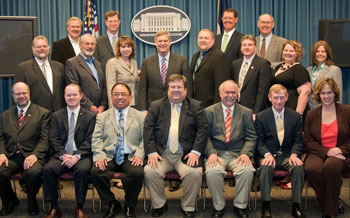 Washington Watch gives NAFB members an opportunity to sit down with folks inside the Beltway and get an update on some of the major issues of concern to agriculture. After Monday’s meetings broadcaster’s had a chance to delve deeper into the hot topics during Issues Forum.
Washington Watch gives NAFB members an opportunity to sit down with folks inside the Beltway and get an update on some of the major issues of concern to agriculture. After Monday’s meetings broadcaster’s had a chance to delve deeper into the hot topics during Issues Forum.
Tuesday we visited USDA where we heard from Secretary of Agriculture Tom Vilsack. He touched on topics from the lack of planting progress this spring to the heartbreaking Birds Point New Madrid levee. I think one of the most important items addressed was the decision to allow crop insurance protections for those affected by the Birds Point New Madrid levee situation (see Cindy’s post earlier this week). We wrapped up Tuesday with a luncheon at the National Press Club with Former Secretary of Agriculture and Former Representative Larry Combest. Tuesday afternoon left time for some Hill visits. I had the opportunity to chat with my Representative, Aaron Schock, and his staff. It’s always a good feeling to leave discussions with the confidence that the agriculture industry is in good hands. Wednesday morning concluded with visits from several of ag’s biggest supporters in the Longworth Building.
One of the most touched on topics in DC this past week was the issue of trade. I had the chance to speak with American Farm Bureau Federation’s Trade Specialist Chris Garza about the current pending free trade agreements.
Garza thinks there is light at the end of the tunnel…
Garza on Trade
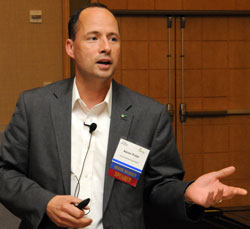 Soybeans came up on the program at the Animal Agriculture Alliance Stakeholders Summit in the form of Aaron Putze, Director External Relations,
Soybeans came up on the program at the Animal Agriculture Alliance Stakeholders Summit in the form of Aaron Putze, Director External Relations, 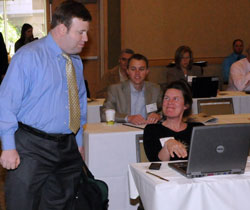 Dairy farmer LuAnn Troxel is one of the attendees here at the Animal Agriculture Alliance Stakeholders Summit. She’s also President of the Indiana Professional Dairy Producers. This is LuAnn chatting with speaker,
Dairy farmer LuAnn Troxel is one of the attendees here at the Animal Agriculture Alliance Stakeholders Summit. She’s also President of the Indiana Professional Dairy Producers. This is LuAnn chatting with speaker, 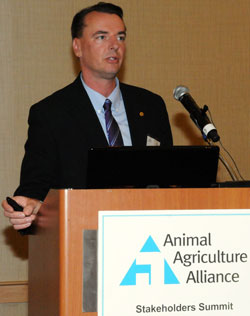 The S word came up during the Animal Agriculture Alliance Stakeholders Summit in a big way during a presentation by
The S word came up during the Animal Agriculture Alliance Stakeholders Summit in a big way during a presentation by 
 “Stamina F3 Cereals arms our growers with an effective seed treatment for their small grain seedlings,” said Don Guy, Marketing Manager, BASF Cereals Portfolio. “As one of our SeedSolutions treatments in our cereals offering, Stamina F3 Cereals delivers excellent disease control, convenience of use and low-dusting application. Stamina F3 Cereals has a red colorant and its higher application rate makes it very suitable for on-farm applications. Stamina F3 Cereals also complements Stamina® F3 HL fungicide seed treatment, which is designed specifically for commercial application.”
“Stamina F3 Cereals arms our growers with an effective seed treatment for their small grain seedlings,” said Don Guy, Marketing Manager, BASF Cereals Portfolio. “As one of our SeedSolutions treatments in our cereals offering, Stamina F3 Cereals delivers excellent disease control, convenience of use and low-dusting application. Stamina F3 Cereals has a red colorant and its higher application rate makes it very suitable for on-farm applications. Stamina F3 Cereals also complements Stamina® F3 HL fungicide seed treatment, which is designed specifically for commercial application.”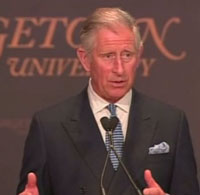 Since the prince has “tried to farm as sustainably as possible for some twenty-six years” he was about the closest to an actual farmer that the conference had on the agenda (
Since the prince has “tried to farm as sustainably as possible for some twenty-six years” he was about the closest to an actual farmer that the conference had on the agenda ( Day one of the
Day one of the 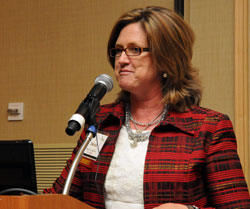 Cattle rancher Debbie Lyons-Blythe talked social media at the Animal Agriculture Alliance Stakeholders Summit. We follow each other on Twitter. Find her
Cattle rancher Debbie Lyons-Blythe talked social media at the Animal Agriculture Alliance Stakeholders Summit. We follow each other on Twitter. Find her 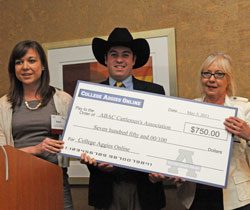 The winner of the
The winner of the